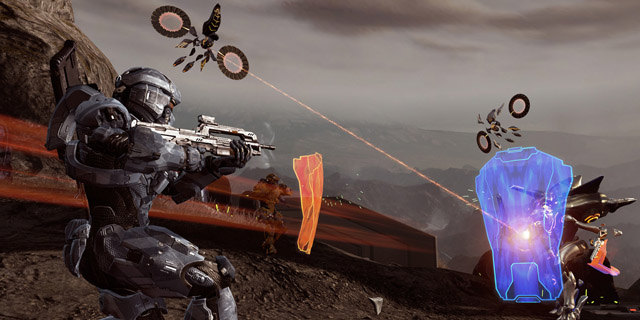
Halo 4 is 343 Industries’ first chance to make their mark on the Halo franchise with a new entry in the series. The team did a pretty good job updating Combat Evolved, so expectations were high going in. Surprisingly, Halo 4 manages to surpass, and includes more pure gameplay than any previous Halo game.
If you somehow haven’t heard yet, surprise! Master Chief survived the destruction of the Forward Unto Dawn at the end of Halo 3, and has been in cryogenic sleep for the last four years awaiting rescue by the UNSC. Unfortunately, no rescue is forthcoming, and instead the ship floats into the gravity well of Requiem, a Forerunner planet that was being investigated by the Covenant.

After a crash landing, you’ll find yourself fighting against the familiar Covenant forces along with a new enemy, the Forerunner technology itself. It’s a great, epic beginning to a new trilogy, and the flashbacks and nods to the backdrop of the Halo universe added in the books is a great touch. It’s much appreciated by those who’ve read them, and adds depth to the story so those who haven’t aren’t missing out.
The gameplay is largely unchanged from previous Halo games, but that doesn’t mean it doesn’t play any better than a two-year-old shooter. The controls are smoother and tighter than in Reach, and the new variations in armor powers and weapons can change the way you play.
As always, you can play the campaign cooperatively, in whole or in part. New to the campaign this time is a challenge aspect, that gives a set of revolving objectives with a set time limit to complete them. These can range from beating specific chapters on specific difficulty levels to playing through areas with specific skulls enabled. Completing these missions gives you experience points to level up your Spartan avatar in the Spartan Hub, the new online profile area.

Many competitive multiplayer modes are either returning intact, like Slayer and Capture the Flag, or returning with changes, such as Oddball moving to a team-based game and Infection being renamed to Flood ( in which Infected players are now Flood-ified Spartans). Some are completely new to the default rotation of game types, such as SWAT, Grifball and Regicide. SWAT and Grifball are popular custom game modes that are making the jump to official playlists, while Regicide is a new Slayer variation where you get extra points for killing the player in first place.
A new progression scheme has been added to Halo 4’s ranking system, heavily influenced by the recent Call of Duty games. When you first start playing, you’ll only have access to the basic human weapons and armor upgrades for your loadout, along with a few game-type-dependent default loadouts to choose from. As you increase your ranking, new weapons and armor powers will be unlocked, along with the ability to save more loadouts, up to four.

None of the weapons or powers are obscenely powerful, but they are a way to customize your starting weapons for your play style. If you are better with SMGs than automatics, or you prefer the Forerunner or Covenant versions of a weapon, you’ll need to play plenty of online games to unlock them. As usual, cosmetic armor mods are also unlocked as you progress through the ranks.
There’s also a new cooperative multiplayer mode called Spartan Ops that is almost like a second campaign, told from the perspective of the UNSC Infinity and its corps of Spartans in an episodic formula. A couple of five-mission episodes have been released thus far, with more planned.
The graphics are by far the best of the Halo series thus far, with many of the cutscenes rivaling the best that have been seen on the 360 to date. The soundtrack is epic, with plenty of new songs mixed in with new versions of old themes.
If you are at all worried about the direction and quality of the Halo franchise in the post-Bungie era, there’s nothing to worry about. Halo 4 sets a new standard for first-person shooters, with more high-quality content than any previous entry.
Pros: Great production values, entertaining story, progressive multiplayer ranks
Cons: Weird physics and A.I. bugs



















